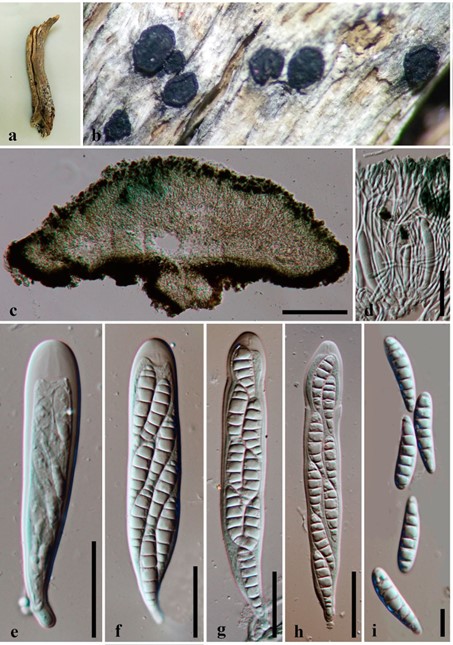Patellaria atrata (Hedw.) Fr., Syst. mycol. (Lundae) 2(1): 158 (1822).
≡ Lichen atratus Hedw., Descr. micr.-anal. musc. frond. (Lipsiae) 2: 61 (1789).
MycoBank number: MB 398671;Index Fungorum number: IF 398671; Facesoffungi number: FoF 00344; Fig. 63
Saprobic on dead stems. Sexual morph: Apothecia 600–1000 × 250–350 µm ( x̄ = 700 × 270 µm, n = 10) arising singly or in small groups, sessile, erumpent from the substrate, black when fresh. Receptacle pulvinate, disc convex, disc and the margins are black in when fresh. Ectal excipulum 20–25 µm ( x̄ = 22.7 µm, n = 10) a narrow layer, 3–4 cells deep, thick, black cells of subglobose to subangularis. Medullary excipulum 10–15 µm ( x̄ = 13.5 µm, n = 10) composed of narrow, long, thin-walled, hyaline to brownish cells of textura porrecta. Hymenium brownish to greenish. Hamathecium comprising 2–3 µm wide ( x̄ = 2.7 µm, n = 20) at the apex, numerous, filiform, septate, branched and swollen at the apex, apices glued together to form epithecium, paraphyses. Epithecium dark green. Asci 75–120 × 12–20 µm ( x̄ = 101.5 × 17.3 µm, n = 30) 8-spored, short to medium pedicellate, cylindric to clavate, rounded at the apex, J-, croziers abscent at the asci base. Ascospore 25–30 × 6–10 µm ( x̄ = 28.1 × 6.8 µm, n = 40), partially bi-seriate, upper and lower spores are uni-seriate, sometimes multi- seriate, hyaline, smooth-walled, ellipsoid, 6–7-septate, distinctly more tapered towards the distal end. Asexual morph: Undetermined.
Material examined: UK, New Forest, on Ulex wood, 9 June 2015, E. B. G. Jones, GJ183 (MFLU 18-1818).
Notes: Our collection failed in ascospore germination and DNA extraction. However, characteristics of our collection are similar to the description of Patellaria atrata provided by Yacharoen et al. (2015).

Fig. 63 Patellaria atrata (MFLU 18-1818). a Substrate. b Apothecia on wood. c Cross section of an apothecium, d Filiform paraphyses. e–g, h Cylindrical asci. i Clavate ascospores. Scale bars: c = 100 µm, d = 50 µm, e–h = 75 µm, i = 10 µm
